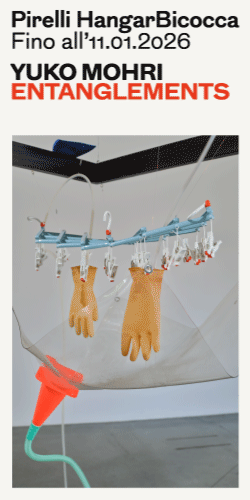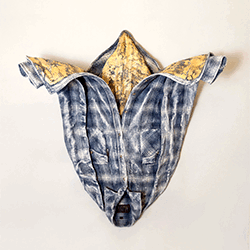[nemus_slider id=”44174″]
Scroll down for the English text
Ha inaugurato lo scorso 28 maggio “Monsieur Fanta!”, la mostra personale di Tiziano Martini alla galleria di Brescia A+B (fino al 27 giugno 2015). Le opere in mostra sono frutto della attuale ricerca svolta presso lo studio concesso dalla Lipsien Art Foundation di Dusseldorf in qualità di residente vincitore del bando per l’anno 2015.
Monsieur Fanta! è il personaggio nel quale l’artista si è involontariamente ritrovato da quando ha iniziato ad indossare un cappello blu con il vecchio logo Fanta. Monsieur Fanta! diventa titolo della mostra perché il logo Fanta ha attivato una curiosa coincidenza con il metodo compositivo dell’artista.
Segue il testo di Gabriele Tosi
Martini frantuma la continuità gestuale dell’azione pittorica sperimentando modi, tempi e materiali in composizioni costruite per fasi. Le sue opere appaiono come stratificati campi visivi, profondamente segnati dall’insistita necessità di negarsi un risultato programmato, intensamente impalcati per registrare l’inatteso potenziale di condizioni materiche complesse, precarie e irripetibili. La ricerca esalta molti dei caratteri sostanziali della pittura. Rende superflua, invece, ogni attenzione simbolica e narrativa. Nello spazio descritto dal supporto si legge dunque una densa commistione di avvenimenti. Le operazioni attivate dall’artista permettono alla quantità di massa cromatica di esprimere diverse trasformazioni, in forza del proprio carattere fisico e chimico. Mentre, il tempo e lo spazio di lavoro sono come registrati dall’opera, la cui natura quasi assorbente è potenziale deposito di materie e gesti limitrofi. La ludica crudità di un’attitudine come questa esaspera il carattere degli elementi compositivi. E’ Il peso della tela che potrebbe cospargere il colore, così come la gravità potrebbe giocare un ruolo fondamentale per segnare le forme in cui la materia si solidifica. L’autore stesso, sfuggente rispetto al detto e al ripetuto, in un certo qual modo prende delle distanze dalla propria opera e diventa anch’egli strumento. Come un regista che abbandona la direzione per lavorare da operatore, tornando a scegliere solo quando lo svolgimento abbisogna di nuove arbitrarietà per avanzare.
Il ciclo di opere esposte presso A+B, corpus completo di una delle vie operative che Martini ha recentemente percorso, conferma tale carattere funzionale. Le tele sono realizzate spandendo sul supporto una cospicua quantità di colori acrilici. I pezzi, come grandi matrici per monotipi, sono poi issati, voltati, stesi e pressati su un materiale plastico disposto a terra. Quando l’acrilico è ritenuto essiccato – Martini non lascia mai passare abbastanza tempo da esserne certo – il pezzo è riportato sul lato frontale e liberato dallo strato plastico. La qualità dello strappo, cauto o violento, definisce così il volume di superficie dell’opera e le conferisce definitive qualità tattili e luministiche. La pratica è influenzata da una innumerevole serie di variabili come Il tempo, i pesi, l’umidità, la conservazione dei materiali, le polveri dello studio. L’artista si pone, rispetto a queste, in maniera passiva. Il suo onere e interesse non è quello di limitare le eventualità. Anche se gestisce empiricamente gli aspetti strutturali, persino i suoi “errori”, come la traccia di una scarpa o un capello assorbito dall’opera, rientrano in un linguaggio che senza avvalersi di interventi diretti denuncia senza sosta il grado di realtà che intende raggiungere.
Nell’approccio dell’autore si cela la cultura visiva con la quale sono state create. Non ha rinunciato, Martini, allo stile, alla manualità e alla presenza. Ciò nonostante non accetta di abbandonarsi alla guida armonica e lineare della materia. E’ lui a comprimerla, spostarla e rimescolarla a sentimento; per poi lasciarla sfogare fino alla sensazione che un nuovo stravolgimento sia necessario. Con le sue opere, Martini segna l’intento di fare pittura senza bisogno di giustificazioni o pretesti. Si pone in una corrente di pensiero profondamente classica, in opposizione all’inconveniente di voler esporre dei dipinti e finire col mettere in mostra sé stessi.

Tiziano Martini, “Monsieur Fanta!”
Martini breaks down the gestural continuity of the creative act in the painting, experimenting different ways, times and materials in his multi-phase works. His paintings are like stratified visual fields, deeply marked by the perseverant need to deny a planned result, strongly decked to find the unexpected potential of complex, precarious and unique material conditions. His research celebrates many substantial features of painting but makes symbolic and narrative attention become redundant. Many and different procedures are to be found on the space described on the frame. Through the artist’s action, the colorful matter creates various transformations because of its physical and chemical features. Simultaneously, work time and space are somehow recorded on the artwork, whose almost absorbent nature can potentially be sediment of bordering matters and gestures. The ludic rawness of this inclination intensifies the character of the compositional elements. The weight of the canvas could spread out the color, as much as gravity could play a significant role in creating the shapes in which the matters solidifies. Fleeing from what is said and repeated, the painter himself takes somehow distances from his work and becomes an instrument of it. Like a film director who leaves the supervision of the movie to become an operator and decides to manage the operations when a new amount of arbitrariness is needed in order to proceed.
The series of works at A+B are a complete collection of the new ways Martini has been experimenting recently and they confirm that functional aspect. He spreads a conspicuous amount of acrylic color on the frame of the canvas. He then lifts, turns, stretches out and presses on a plastic surface on the ground the various parts, like big matrixes for monotypes. When the acrylic is supposed to be dry – Martini never waits enough to be sure about it – he affixes every part on the front side and tears off the plastic surface. The quality of the rip, cautious or violent, defines the volume of the surface of the painting and creates final tactile and light features. The result of these procedures depend on countless variables, such as time, weight, humidity, the conditions of the implied materials, the dust in the studio. The artist is passive in front of these. His duty and his interest are not to limit these possibilities. Even if he practically manages the structure of the work, his “mistakes”, such as the trace of shoes or a hair that have been absorbed in the artwork, are part of a language that reports the amount of reality he wants to reach, without any direct intervention.
The painter’s approach hides the visual culture that created the works. Martini did not give up his manner, his manual skill and his presence, although he does not accept to be harmoniously and linearly guided by the matter. He is the one who compresses it, moves and mixes it according to his feelings, but lets it pour out itself until he senses it is time for a new intervention. With these works, Martini shows his intention to paint without explanations or excuses. He puts himself in a very traditional way of thinking against the risk of trying to exhibit paintings and end up exhibiting themselves.
Text by Gabriele Tosi.









